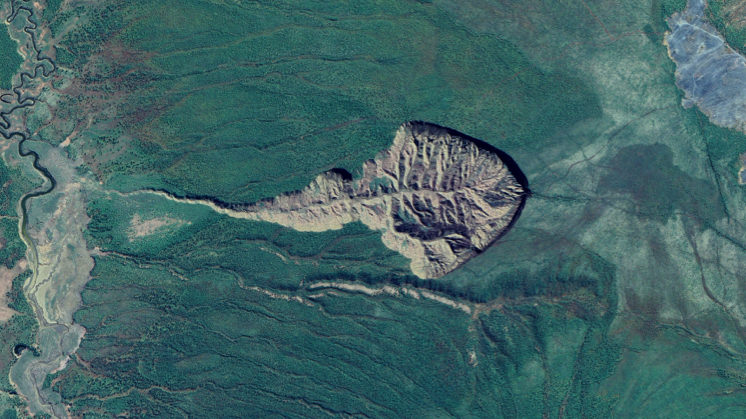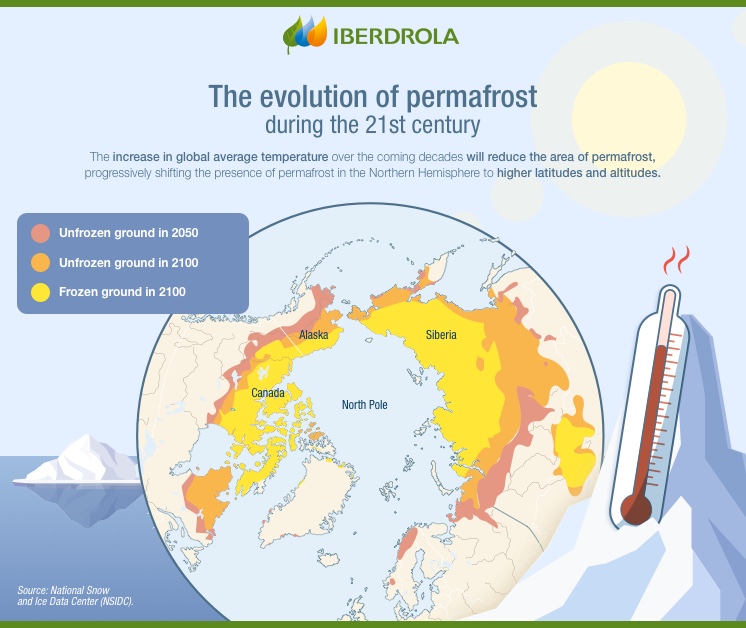What is permafrost
Melting permafrost: why is it a serious threat to the planet?
You may not know what permafrost is, but its melting, which is advancing due to climate change and has reached a critical point, could have serious consequences for your future. This permanently frozen ground, located in circumpolar areas in Canada, Alaska, Siberia and elsewhere, has acted as a carbon sink for thousands of years and if it thaws it could release large amounts of this gas, amplifying the problem of global warming.

Climate change is already affecting the whole world in the form of extreme weather events, some of which have made headlines in recent times. Behind these phenomena is the increase in greenhouse gas (GHG) emissions driven by human activities, which has warmed the planet by 1.1 ºC from the period 1850-1900 to the present, according to the Intergovernmental Panel on Climate Change (IPCC).
In addition to the threats in the form of heat waves, torrential rains or hurricanes, there is another, more serious and less talked about threat that lurks beneath the surface: the melting of the permafrost. As temperatures rise, this permanently frozen layer will melt and release giga-tonnes of gases, such as carbon and methane, as well as ancient viruses and bacteria, resulting in serious consequences for both the regions where it is located and the planet as a whole.
Definition of permafrost
Permafrost is terrain that has been frozen for at least two years and consists of soil, rocks and sediments amalgamated into a whole by ice, which acts as cement. It can range in depth from a few centimetres to hundreds of metres and is covered by the so-called active layer, a layer of earth at the surface that melts in summer, although permafrost is also sometimes found at the surface.
Most of today's permafrost was formed during and since the Ice Age and, due to its age, it has been accumulating large amounts of methane and carbon — the main GHGs — from the decomposed organic matter within it. According to some sources, the amount of carbon retained in permafrost is almost double the amount in the atmosphere. Therefore, its thawing and its consequent release of gases poses a serious threat in the fight against climate change.
Where permafrost is found
Due to the low temperatures necessary for its formation, permafrost is a phenomenon endemic to cold climates. Specifically, most of the Earth's permafrost is found in the northern hemisphere - Siberia, Tibet, Greenland, Alaska, etc., which is home to around 23 million km2 according to the National Snow and Ice Data Center (NSIDC) — which is equivalent to 25 % of the Earth's land surface in this part of the world —. In the southern hemisphere, it can be found in places such as the Andes, the Southern Alps and South Georgia, among others.
It is also worth mentioning that there is also permafrost underwater. In particular, part of the Arctic Ocean sea floor around the North Pole is frozen. This submarine permafrost was formed more than 11,000 years ago during the Ice Age in regions that were on the surface and were buried under water at the end of the glaciation.

Reasons the permafrost is melting
The planet's permafrost is melting, and the main culprit is the rise in the Earth's average temperature. In fact, the situation is worse than previously thought. An international team of climate scientists has studied the melting of the permafrost in Siberia and Canada and warned that it will thaw 20 % more than previous research anticipated.
According to the study, published in the journal Nature Climate Change, a global temperature increase of 1 ºC above pre-industrial levels would result in a loss of permafrost slightly larger than the size of India, which is almost four million km2, while a 2 ºC increase would result in the loss of 40 % of the world's permafrost. If the Paris Agreement is met, which set a target of keeping global warming below 2 °C by aiming to limit it to 1.5 ºC, much of the planet's permafrost would be saved.
Consequences of the melting of the permafrost
The melting of permafrost has catastrophic consequences for the planet and for life:
 Release of greenhouse gases
Release of greenhouse gases
As mentioned above, the permafrost holds gigatonnes of methane and carbon dioxide in the subsoil. Their gradual release would lead to an acceleration of global warming which in turn would accelerate the melting of the remaining permafrost — a phenomenon known as the permafrost carbon feedback cycle.
 Release of viruses and bacteria
Release of viruses and bacteria
In August 2016, in the Siberian tundra, a 12-year-old boy died and dozens of people were hospitalised due to an outbreak of anthrax released by the thawing of a layer of permafrost on which a reindeer carcass was lying. Scientists have found microbes that are over 400,000 years old in permafrost, so many of the viruses that have plagued humanity throughout its history — such as bubonic plague and smallpox — are believed to lie dormant in this frozen stratum.
 Damage to ecosystems and their biodiversity
Damage to ecosystems and their biodiversity
Melting Siberian permafrost is turning parts of the tundra into muddy landscapes, causing the local flora to disappear and the wildlife that feeds on it to starve. Furthermore, when the permafrost beneath water bodies, such as lakes, melts, the water seeps into the ground and disappears, causing droughts.
 Landslides and geological accidents
Landslides and geological accidents
As the ice that acts as cement binding the permafrost materials together melts, landslides can occur in cities built on the permafrost. In Russia, where more than 60 % of the land is permafrost, this problem is particularly acute and Yakutsk, the largest city built on permafrost, already suffers from it. The Batagaika crater, caused by thawing permafrost and a deforestation process that caused the land to give way, is the image that best exemplifies the magnitude of the problem.




